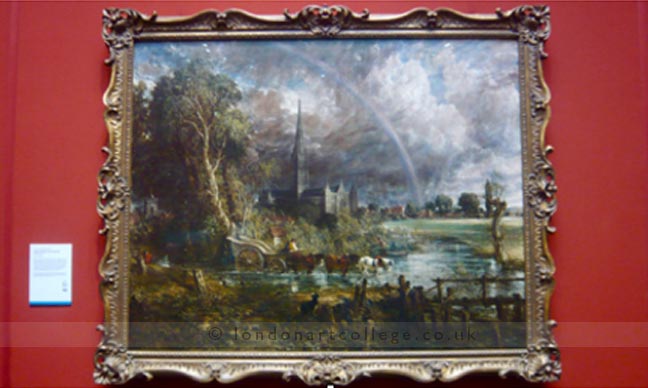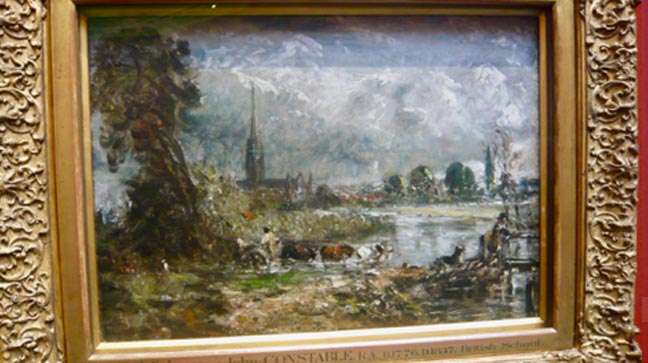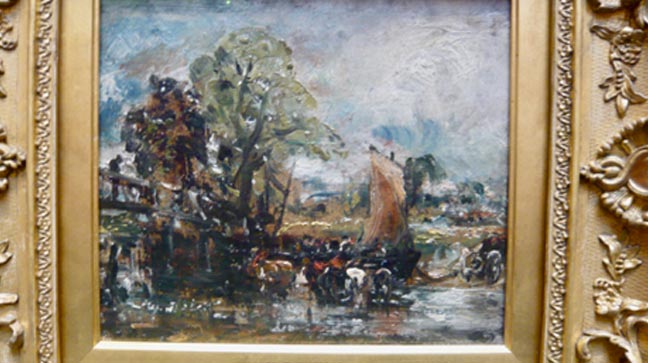The following post has been taken from one of our History of Art students assignment al about the Hay Wain by Keith Phillips. We had such a fantastic response to our last History of art blog post we hope you enjoy reading this one too.
Art – A World History course.
Constable’s Hay Wain – which one student described as ‘a marmite painting’, continues to produce excellent responses on the Art – A World History course. For those of you who still think of it as a ‘chocolate box’ image I offer another recent response .
The following are two sections from a very full description of the painting and the context in which it was produced. The student, Keith Phillips confessed
“I have never been over impressed with Constable, probably due to the overuse of his imagery, most notably of the Hay Wain. Having completed this assignment I have changed my mind!”
4. How was it produced? What materials/techniques were used?
The Hay Wain is a painting by John Constable, finished in 1821, using oils on canvas, this large painting, 130 cm × 185 cm, depicts a rural scene on the River Stour between the English counties of Suffolk and Essex. It hangs in the National Gallery. When the painting was originally exhibited, it was titled ‘Landscape: Noon’, the finished painting was referred to by Constable’s friend Archdeacon Fisher as ‘The Haywain’ as early as February 182, and this became its popular name.
Unlike many of his contemporaries Constable painted from nature rather than thinking up a composition in his minds eye prior to beginning a piece. He was excited by the prospect of ever changing nature and the way that no view ever looked the same from one day to the next. He would often complete primary sketches prior to starting a large canvas, Constable would draw on the inspiration nature gave him and try to capture a moment in time, testing his composition first in oil and pencil sketches. Such sketches would be produced in a grid formation so that they could be accurately scaled up when the artist started to work on larger canvases at a later date. A number of the preliminary studies for this composition have survived enabling us to gain an insight into Constable’s method of work. To begin with, there are the sketches from nature made in his early years, upon which he drew throughout his career. There is a small oil sketch of Willy Lott’s cottage in the Victoria and Albert Museum which has been dated about 1810-15. Constable’s practice was to use oil sketches, he blocked in the main features in broad masses of strong, bright colours, giving the work a rough texture and a surprisingly modern appearance, even as a young boy Constable would spend hours sketching, notable where his sketches of clouds, in what he referred to as his ‘skying’ sessions. This development and skill is evident in his later works as the artist perfectly recreates cloud formations and sunlight. Years later, he made use of such early sketches when he was devising the composition of ‘The Hay Wain’. Constable now faced the problem of converting these small, broadly executed oil sketches into a carefully composed much larger canvas. It was at this point that he produced the large sketch, a full scale treatment of the subject but with the details only roughly indicated, the background merely blocked in and the predominant tone provided by the light brown canvas on which it is painted. The finished picture in the National Gallery differs hardly at all in composition from this large sketch, only a figure on horseback in the foreground has disappeared.
Until Constable became popular many landscape artist used what is known as ‘coffee colours’ to create their works, especially the great Dutch masters whose works were considered to be the epitome of good landscape painting. However Constable’s challenging and often stubborn nature led him to rebel against this convention, using natural tones and vibrant greens to match the colours he saw in the countryside. He even argued that the browns of classical landscapes were in fact down to the varnish used on those canvases and it may have been the intention of the masters to use vivid colours originally. He created new techniques to give the realistic appearance of flowing water and wind blowing through trees, by layering reds with the greens of his trees, he was able to create depth in a way which had never been done before, not only this, but the reds added a vibrancy to the trees, something that was missing from classical landscapes. Constable used white highlights to illuminate water moving against people and agricultural equipment. This gave the impression of sunlight reflecting in the image, enhancing the realism of many of Constable’s paintings. Constable had a somewhat advanced style compared to many of his contemporaries. His use of broad and naturalistic brushstroke was frowned upon by The Royal Academy and did not earn him many patrons in England, this Impasto technique however, went on to be fully developed by The Impressionists of the late 19th and early 20th centuries.
5. Why was this painting better received in France than in England?
Although The Hay Wain is revered today as one of the greatest British paintings, when it was originally exhibited at the Royal Academy in 1821 (under the title Landscape: Noon), it failed to find a buyer. Constable’s work was not very well received by his contemporaries in Britain, who believed that the ideal landscape should mirror those of Claude Lorrain. Also, they didn’t appreciate Constable’s innovative used of the ‘impasto’ technique.
After the Royal Academy exhibition Constable sent this painting along with others to France, where he was asked to exhibit a number of pieces at the Paris Salon in 1824, it was considerably better received in France where it caused a sensation. In that exhibition, The Hay Wain was singled out for a gold medal awarded by Charles X of France, a cast of which is incorporated into the picture’s frame. The works by Constable in the exhibition inspired a new generation of French painters, including Eugène Delacroix and Camille Corot. Eugène Delacroix was apparently so struck by Constable’s use of broken colour and flickering light that he repainted the background of his dramatic masterpiece Scenes from the Massacres of Chios 1824. When Delacroix visited London in 1825 it is probable that he paid a visit to Constable’s studio, as his journal includes an accurate account of Constable’s technique. Constable’s approach also inspired artists to work directly from everyday life and use nature as the main subject of their painting, rather than simply as a backdrop for dramatic classical or historic scenes. They began to venture out of Paris and into the countryside to work directly from the landscape. A main destination was the Forest of Fontainbleu, an easy train-ride from Paris. One of the villages on the edge of the forest, Barbizon, became a popular place for artists to stay during their sketching trips. These artists, including Theodore Rousseau and Camille Corot, later became known as the Barbizon School. The Barbizon painters also responded to Constable’s handling of paint. The broad strokes and loose marks in Constable’s paintings seemed to record the vigorous movements of the artist’s hand, unlike academic conventions which tended to suppress those kinds of traces. Another artist associated with the School, Jean-Francois Millet, added a human dimension to this new approach to landscape painting. In paintings such as The Gleaners 1857, farm workers are shown harvesting or labouring within the landscape. There is no drama or narrative, simply the documenting of everyday life. This type of work belongs to a movement known as ‘realism’
Constable’s success on continental Europe established his reputation and allowed him to finally make money from his art.
I attach a couple of images taken recently at an exhibition in The National Gallery of Scotland, where some of Constable’s oil sketches were shown alongside his finished painting of Salisbury Cathedral from the meadows – another of his ‘six footers’.
Keith Phillips
History Of Art Course
Salisbury Cathedral from the Meadows 1831
Smaller oil sketch for the above
Even looser oil sketch ‘On the Stour 1830’



